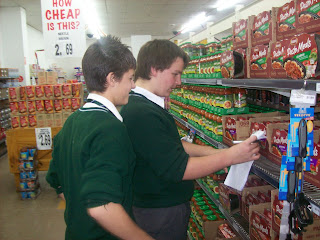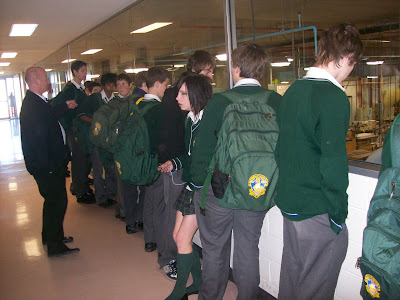As mentioned in our previous transmission, the Local Experience is well and truly underway now, and the boys are looking to tomorrow to commence the “Human Impact” task (investigating Mordialloc Creek, the foreshore, and the interchange). Below are a set of instructions for them to follow to ensure that their responses are quality ones:
Before I provide the “Human Impact” instructions, a reminder that our Information Evening regarding Community Placements (which start this Thursday) and the upcoming City Experience (immediately after Placements) is on here at Mordialloc College on Wednesday October 29, in the MEX room commencing at 7:00pm sharp. Parents and guardians, have your questions answered in this one-hour (approximate) session, and see for yourself what these programs are all about.“HUMAN IMPACT” TASK
Period 1To begin with, we need to form our action groups and create a table to record information of our visit to Mordialloc Creek, the foreshore and the interchange (where the creek meets the bay). The table needs to have three columns: one to record the human impact we can see on the creek, the second column for the impact we see at the foreshore, and the third for the impact at the interchange).
You will hand this table in as part of your submission, so make sure all group members’ names are on the sheet!
What we could be looking for:
Litter in the water, and/or items dumped in the water (eg: food wrappers, plastic bags, that TV we saw dumped off the bridge into the creek, and particularly what’s been caught in the litter trap at the fork in the creek)
The water quality (ie: is the water relatively clear / murky / smelly / polluted?)
Litter on the ground
Man-made structures (eg: the pier, drainpipes, the boat ramp, buildings, paths, car parks, etc)
Any noticeable impact on flora or fauna (plants and animals), both positive and negative
Any other signs of conservation (eg: no-go zones for humans to enter, protection for newly planted vegetation, signs indicating council regulations, etc)
Mr E will have the camera with him, and will place the photos on the network for you to download afterwards; follow these links:
student subs : Mordi experience_08 : Photos and Videos : Local Experience : Term 4Periods 2 - 4
From this point on in the day, you will have substitute teachers looking after you (Ms Coombs will be away). This is not an excuse to sit there and do nothing, gentlemen!
At this point, you should have filled in your table of three columns with your observations from our visit down the creek and foreshore during Period 1. Please do a good copy of this information and print out; all group members’ names should be on your sheet.
The next thing you do is collect a copy of the UBD Street Directory (we have a class set of these: ask Mrs Hume nicely to retrieve these from our storage cupboard). There should be enough copies for one between two or three of you. Turn to Map 376. Your next task is to measure how many metres of beach there is in Mordialloc:
Have a look at the bottom left corner of this map. You will see a thin red line running down the middle of Mordialloc Creek; this indicates the suburb boundary between Mordialloc and Aspendale. Move along the beach past where it says “Dressing Shed” and you will see another thin red line splitting the beach, running upwards into Bay Street; this is the suburb boundary between Mordialloc and Parkdale. The beach area between these two red lines (Mordialloc Beach) is the area that you will measure.
You will notice underneath where it says Map 376, it says “1 Kilometre Equals 4 Grid Squares”.
If 4 grid squares = 1 kilometre, then 1 grid square = 250 metres
The actual length and width of each grid square is approximately 12 millimetres. This means that to work out our scale, we need to divide 250 (the scale distance) by 12 (the actual distance)
This means our scale is 1 millimetre = 20.83 metres
Use this scale to measure the length of Mordialloc Beach and record your answer
Now what you need to do with your information is collate it into a poster or a PowerPoint presentation. In addition to your table of observations, and your measurement of Mordialloc Beach, you need to include (in your own words!):
Some overall information about Mordialloc Creek
http://www.melbournewater.com.au/content/rivers_and_creeks/river_health/dandenong_waterways/mordialloc.asphttp://www.kingston.vic.gov.au/Page/page.asp?Page_Id=673&h=0History of Mordialloc Creek
http://localhistory.kingston.vic.gov.au/htm/article/228.htmThe Mordialloc Creek interchange: how popular it is for boats
http://www.kingston.vic.gov.au/Page/page.asp?Page_Id=913&h=0Information about the types of wildlife that live in Port Phillip Bay
http://www.parkweb.vic.gov.au/1park_display.cfm?park=58Comparison of Mordialloc Beach to Edithvale and Mentone Beaches
http://www.bayside.vic.gov.au/beachguide/beaches1.htmhttp://www.bayside.vic.gov.au/beachguide/beaches2.htmHow does Bondi Beach compare to Mordialloc Beach?
http://www.bondivillage.com/How does Venice Beach in California compare to Mordialloc Beach?
http://www.venicebeach.com/Solutions for reducing pollution in our bays and creeks (don’t forget to create a slogan for people to remember!)
http://www.cleanupaustralia.com.au/http://www.cleanocean.org/Reflection on this activity (ie: what have you learned, has completing this task convinced you to change your impact on the creek and beach, etc)






















































